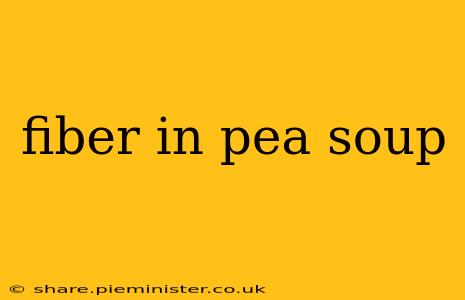Pea soup, a comforting and flavorful staple in many cuisines, offers more than just taste; it's a surprisingly good source of dietary fiber. Understanding the fiber content and its benefits can help you appreciate this humble dish even more. This post dives deep into the fiber content of pea soup, exploring various types, preparation methods, and how to maximize its nutritional value.
How Much Fiber is in Pea Soup?
The fiber content of pea soup varies depending on several factors: the type of peas used (dried or fresh), the recipe (added ingredients like vegetables or grains), and the serving size. Generally, a single serving (around 1 cup) of homemade pea soup made with dried green peas can contain anywhere from 4 to 8 grams of fiber. This can fluctuate based on the ingredients and preparation method. Using a higher proportion of peas to broth will naturally increase the fiber content. Conversely, cream-based or blended pea soups may have slightly less fiber due to the alteration of the pea's structure. Always refer to your specific recipe or nutritional analysis for the most accurate information.
What Types of Fiber Are in Pea Soup?
Pea soup primarily contains two types of fiber: soluble and insoluble.
-
Soluble fiber: This type of fiber dissolves in water, forming a gel-like substance that can help lower cholesterol and regulate blood sugar levels. Peas are a decent source of soluble fiber, contributing to the overall fiber content of the soup.
-
Insoluble fiber: This type of fiber does not dissolve in water and adds bulk to the stool, promoting regularity and preventing constipation. The skins and outer layers of peas contribute significantly to the insoluble fiber in pea soup.
The balance between soluble and insoluble fiber varies depending on the type of pea and cooking methods.
Does the Type of Pea Affect Fiber Content?
Yes, absolutely! Different types of peas have varying fiber content. Generally, dried green peas tend to be higher in fiber than fresh or frozen peas. This is because the drying process concentrates the nutrients, including fiber. Split peas, often used in split pea soup, also offer a high fiber content.
How to Maximize Fiber in Your Pea Soup?
To boost the fiber content of your pea soup even further, consider these tips:
- Use dried peas: As mentioned above, dried peas offer a higher fiber concentration than fresh or frozen varieties.
- Add other fiber-rich ingredients: Incorporate vegetables like carrots, celery, and spinach, or whole grains like barley or brown rice to increase the overall fiber in your soup.
- Leave some peas whole: While blending creates a smoother texture, leaving some peas whole preserves more fiber.
- Avoid cream-based versions: Creamy soups often contain added fats and less fiber than broth-based versions.
Is Pea Soup Good for Digestion?
Yes, pea soup can be beneficial for digestion due to its fiber content. Both soluble and insoluble fiber play vital roles in digestive health. Soluble fiber helps regulate bowel movements and can relieve constipation, while insoluble fiber adds bulk to the stool, promoting regular bowel movements. However, it’s crucial to increase your fiber intake gradually to avoid digestive discomfort.
Can Pea Soup Help with Weight Loss?
The high fiber content in pea soup can contribute to weight management. Fiber promotes satiety, meaning you feel fuller for longer, which can help control your appetite and reduce overall calorie intake. However, weight loss is a multifaceted process involving diet and exercise, and pea soup alone won't guarantee weight loss.
What Are the Health Benefits of Pea Soup?
Beyond fiber, pea soup offers a range of other health benefits. It's a good source of protein, vitamins (like vitamin K and vitamin C), and minerals (like iron and potassium). These nutrients contribute to overall health and well-being. The antioxidants present in peas also offer protection against cell damage.
In conclusion, pea soup is a delicious and nutritious meal offering a significant amount of dietary fiber, crucial for digestive health and overall well-being. By understanding the factors influencing its fiber content and following tips to maximize its nutritional value, you can fully enjoy this wholesome and flavorful dish.
